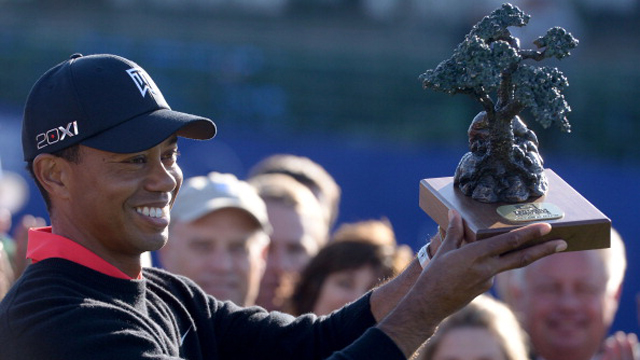NEWS
What you can learn from Tiger Woods' win at the 2013 Farmers Insurance Open

Those of you who were surprised by Tiger Woods' runaway win at Torrey Pines in his first start after missing the cut in Abu Dhabi haven’t been paying attention. The man is the master of the bounce-back.
History bears this out. Throughout his career, any time Tiger plays poorly (and on those rare occasions when he misses a cut) he almost always comes back stronger than ever in his next start. In 2006, for example, he missed the cut at the U.S. Open, and in his next start he finished second in the Western Open. Then he reeled off seven consecutive victories, including two major championships.
This win at Torrey was particularly telling. In Abu Dhabi he hit the ball sideways, finding the desert as often as the fairway. He even hit a cold top with a driver, a shot so un-Tiger-like it was an immediate YouTube hit. Yet just days later in San Diego he drove the ball efficiently and effectively, not hitting every fairway, but finding the short grass when it counted and making some of the best swings people have seen from him in some time.
So, how does he do it? How does Tiger find a winning game mere days after struggling to find a fairway? How does he go from appearing lost and unsure of his swing to looking unstoppable and dominating in a way no one else can?
And most importantly, what can you learn from Tiger’s ability to bounce-back after disappointment?
First, like most world-class athletes, Tiger is a man who rarely ever looks back. Everything about him is forward leaning. He doesn’t like bad shots, and will let the world know it, but he doesn’t dwell on them, either. Once a shot or a round or a tournament is over, Tiger has the unique ability to forget about them and press ahead to the next objective.
Secondly, Tiger has an uncanny ability to focus on the good and forget the bad, even in a tournament where there was more bad than good. During his interviews after missing the cut, he didn’t dwell on the bad shots he hit – in fact he wouldn’t talk about them except to dismiss them – but he did talk about the positives he was able to take away from his rounds.
This is a pattern, not just with Tiger but with most professionals. It is also the biggest difference I see between great players and those who struggle with their games. Go into any locker room or 19th hole and listen to amateurs talking after a round. Invariably you will hear them rehashing the bad shots and recounting the missed putts. And you will hear them beating themselves up.
Go into any professional locker room or the players’ lounge at any tour event, and you will mostly hear positive descriptions of shots or putts or rounds. Great players always find the pearl, even in the blackest of waters.
Finally, Tiger has what I like to call the “shooters’ mindset.” If he were a basketball player, he would be the guy who always wanted to take the final shot, even if he had missed his last six. He would want the ball, because in his mind, those six missed shots were anomalies. The next one was going down, or so he would convince himself.
Most amateurs want to get off the stage as quickly as possible, especially if they’ve just shanked a shot or flubbed a chip or pushed a short putt. Guys like Tiger always want to be in the spotlight. They always want to have the shot to win.
That is the shooter mindset. And that is what makes them great.
Chris Czaja is the 2010 South Florida PGA Section Teacher of the Year. You can learn more about Chris by visiting his website at www.christianczaja.com